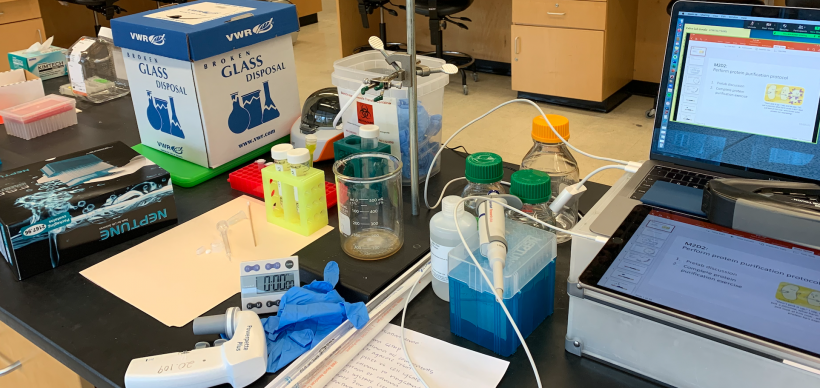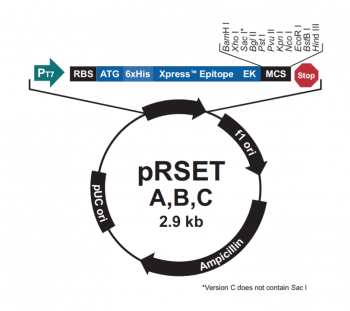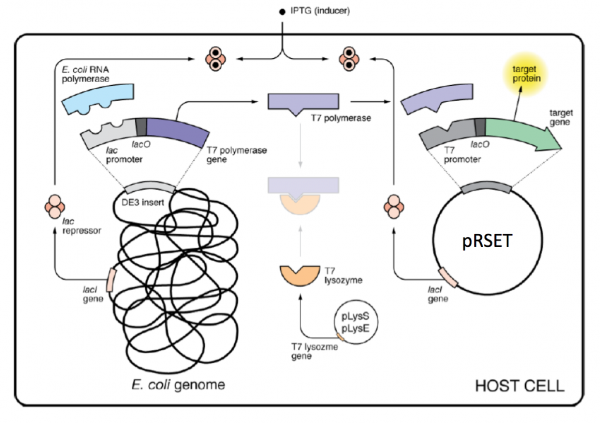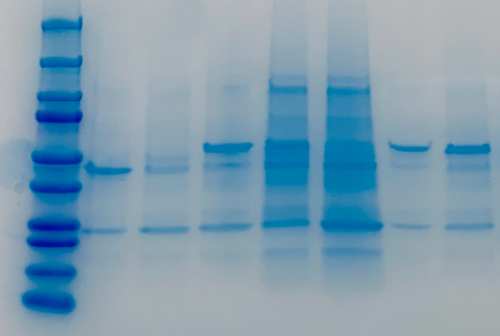Difference between revisions of "20.109(S21):M3D2"
Noreen Lyell (Talk | contribs) (→Part 1: Review expression system used to purify IPC and IPC variants) |
Noreen Lyell (Talk | contribs) (→Part 2: Evaluate purified IPC) |
||
| Line 30: | Line 30: | ||
===Part 2: Evaluate purified IPC=== | ===Part 2: Evaluate purified IPC=== | ||
| − | + | Quick note on cloning and purification... | |
To evaluate the purified IPC protein, we will use the same methods as when we assessed purified TDP43-RRM12: SDS-PAGE and microBCA (this is a variation of the BCA procedure that is used to measure lower protein concentrations). To review these methods, look back at the information provided on [[20.109(S21):M2D2 |M2D2]]! | To evaluate the purified IPC protein, we will use the same methods as when we assessed purified TDP43-RRM12: SDS-PAGE and microBCA (this is a variation of the BCA procedure that is used to measure lower protein concentrations). To review these methods, look back at the information provided on [[20.109(S21):M2D2 |M2D2]]! | ||
| Line 47: | Line 47: | ||
'''Measure concentration using microBCA''' | '''Measure concentration using microBCA''' | ||
| − | + | [[Image:Sp21 M3D2 microBCA data.png|thumb|500px|center|'''microBCA results to calculate concentration of IPC and IPC variants.''']] | |
| − | # | + | <font color = #4a9152 >'''In your laboratory notebook,'''</font color> complete the following: |
| − | + | *Use the microBCA data to generate a standard curve and calculate the protein concentrations for the Variant IPC and WT IPC purification samples (spreadsheet with values attached [[Media:Sp21 M3D2 microBCA data for IPC.xlsx |here]]). | |
| − | + | ||
| − | + | **Attach the standard curve and the calculations for the Variant IPC and WT IPC concentration calculations. | |
| + | *Based on the percentage you estimated above, what is the actual concentration of the Variant IPC and WT IPC in the purification samples. | ||
===Part 2: Advance preparation for SDS-PAGE of protein extracts=== | ===Part 2: Advance preparation for SDS-PAGE of protein extracts=== | ||
Revision as of 19:40, 19 April 2021
Contents
- 1 Introduction
- 2 Protocols
- 3 Reagents list
- 4 Navigation links
Introduction
In the previous laboratory session, you examined the structural features of IPC. The goal of this was to consider which residues are important to affinity and / or cooperativity. Today you will consider the mutations that were generated in IPC by previous 109ers. But first let's review how IPC and the IPC variants were expressed and purified as this is the first step in testing how the variants perform as calcium sensors.
The genetic sequences that encode the IPC protein and IPC variant proteins are maintained within the pRSET expression vector (recall the cloning exercise from M3D1!). This expression vector contains several features that are important to the expression and purification of IPC and the IPC variants. To enable selection of bacterial cells that carry pRSET_IPC, an antibiotic cassette, specifically an ampicillin marker, is included on the vector. The features most relevant to protein expression and purification are highlighted in the schematic to the right. The T7 promoter drives expression of the gene that encodes IPC (or IPC variant). To ensure that the transcript is translated into a protein, a ribosome binding site (RBS) is included. The ATG sequence serves as the transcriptional start and the 6xHis represents the six-histidine residue tag that is used for protein purification via affinity chromatography.There are some similarities between the expression system used to purify TDP43-RRM12 in Mod 2 and the system we will use for IPC. First, in both expression systems IPTG is used to induce protein production. As a review, IPTG is a lactose analog that induces expression by binding to the LacI repressor. When bound to IPTG, the LacI repressor is not able to bind to the lac operator sequence and transcription occurs unimpeded. For more details please review to the M2D1 Introduction! Another similarity is that a 6His tag is used and 6His-tagged IPC and IPC variants will purified using column affinity as shown in the image below. There are also several differences between the expression systems for TDP43-RRM12 and IPC. As you read through the exercises below, consider how these steps are different from those used previously.
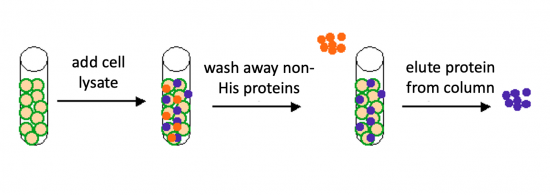
Protocols
Part 1: Review expression system used to express IPC and IPC variants
As mentioned above, IPTG is used to induce protein production in the expression systems for TDP43-RRM12 and IPC; however, the mechanism that drives transcription of the gene that encodes the protein of interest is different. For IPC and the IPC variants, the proteins are expressed using the BL21(DE3)pLysS strain of E. coli, which has the following genotype: F-, ompT hsdSB (rB- mB-) gal dcm (DE3) pLysS (CamR).
The expression vector, pRSET, encodes the bacteriophage T7 promoter, which is active only in the presence of T7 RNA polymerase (T7RNAP), an enzyme that therefore must be expressed by the bacterial strain used to make the protein of interest. In BL21(DE3), T7RNAP is associated with a lac construct. Constitutively expressed lac repressor (lacI gene) blocks expression from the lac promoter; thus, the polymerase will not be produced except in the presence of repressor-binding lactose or a small-molecule lactose analogue such as IPTG (isopropyl β-D-thiogalactoside). To reduce ‘leaky’ expression of the protein of interest (in our case, IPC), the pLysS version of BL21(DE3) contains T7 lysozyme, which inhibits basal transcription of T7RNAP. This gene is retained by chloramphenicol selection, while the pRSET plasmid itself (and thus IPC) is retained by ampicillin selection.
The pRSET_IPC and pRSET_IPC variants were transformed into chemically competent BL21(DE3)pLysS using heat shock as described previously. To review this method, look back at the information provided on M1D3!
In your laboratory notebook, complete the following:
- questions about expression system...
Part 2: Evaluate purified IPC
Quick note on cloning and purification...
To evaluate the purified IPC protein, we will use the same methods as when we assessed purified TDP43-RRM12: SDS-PAGE and microBCA (this is a variation of the BCA procedure that is used to measure lower protein concentrations). To review these methods, look back at the information provided on M2D2!
Assess purity using SDS-PAGE
In your laboratory notebook, complete the following:
- Evaluate the purified protein product for each of the Variant IPC and the WT IPC.
- Do you see a band that corresponds to the expected protein size? Edit the image of the SDS-PAGE results such that the expected band in each lane is highlighted.
- Attach the edited image.
- Are the purified protein products for each of the Variant IPC and the WT IPC pure?
- Estimate how much of the total protein in each purified protein product is the Variant IPC or WT IPC. (Note: this is just an estimate, do your best to gauge the percentage of Variant IPC or WT IPC protein in each sample by considering the intensities of all of the bands in the lane.)
Measure concentration using microBCA
In your laboratory notebook, complete the following:
- Use the microBCA data to generate a standard curve and calculate the protein concentrations for the Variant IPC and WT IPC purification samples (spreadsheet with values attached here).
- Attach the standard curve and the calculations for the Variant IPC and WT IPC concentration calculations.
- Based on the percentage you estimated above, what is the actual concentration of the Variant IPC and WT IPC in the purification samples.
Part 2: Advance preparation for SDS-PAGE of protein extracts
- Last time you measured the amount of cells in each of your samples (-IPTG and +IPTG of the wild-type IPC and one correct mutant). (If you ran cultures overnight, the teaching faculty measured the +IPTG samples for you and posted the results.) Look back at your measurements, and find the sample with the lowest cell concentration. Set aside 15 μL of this sample for PAGE analysis in an eppendorf.
- For your other three samples, you should take the amount of bacterial lysate corresponding to the same number of cells as the lowest concentration sample. For example, if the OD600 of your WT -IPTG sample was 0.05, and the OD600 of your WT +IPTG sample was 0.30, you would take 15 μL of the -IPTG, but only 2.5 μL of the +IPTG sample.
- Next, add enough water so the each sample has 15 μL of liquid in it. You might use the table below to guide your work.
- Finally, add 3 μL of 6X sample buffer to 15 μL of each of your diluted lysates. These will be stored in the freezer until next time.
| Sample Name | OD600 | Sample Volume (μL) | Water Volume (μL) | Total Volume (μL) |
|---|---|---|---|---|
| -IPTG WT | 15 | |||
| +IPTG WT | 15 | |||
| -IPTG mutant | 15 | |||
| +IPTG mutant | 15 |
Part 4: Protein concentration
Part 4A: Prepare diluted albumin (BSA) standards
- Obtain a 0.25 mL aliquot of 2.0 mg/mL albumin standard stock and a conical tube of diH2O from the front bench.
- Prepare your standards according to the table below using dH2O as the diluent:
- Be sure to use 5 mL polystyrene tubes found on the instructors bench when preparing your standards as the volumes are too large for the microcentrifuge tubes.
| Vial |
Volume of diluent (mL) | Volume (mL) and source of BSA (vial) | Final BSA concentration (μg/mL) |
|---|---|---|---|
| A | 2.25 | 0.25 of stock | 200 |
| B | 3.6 | 0.4 of A | 20 |
| C | 2.0 | 2.0 of B | 10 |
| D | 2.0 | 2.0 of C | 5 |
| E | 2.0 | 2.0 of D | 2.5 |
| F | 2.4 | 1.6 of E | 1 |
| G | 2.0 | 2.0 of F | 0.5 |
| H | 4.0 | 0 | Blank |
Part 4B: Prepare Working Reagent (WR) and measuring protein concentration
- Use the following formula to calculate the volume of WR required: (# of standards + # unknowns) * 1.1 = total volume of WR (in mL).
- Prepare the calculated volume of WR by mixing the Micro BCA Reagent MA, Reagent MB, and Reagent MC such that 50% of the total volume is MA, 48% is MB, and 2% is MC.
- For example, if your calculated total volume of WR is 100 mL, then mix 50 mL of MA, 48 mL of MB, and 2 mL of MC.
- Prepare your WR in a 15 mL conical tube.
- Pipet 0.5 mL of each standard prepared in Part 4A into clearly labeled 1.5 mL microcentrifuge tubes.
- Prepare your protein samples by adding 990 μL of dH2O to your 10 μL aliquot of purified protein, for a final volume of 1 mL in clearly labeled 1.5 mL microcentrifuge tubes.
- Add 0.5 mL of the WR to each 0.5 mL aliquot of the standard and to your 0.5 mL protein samples.
- Cap your tubes and incubate at 60°C in the water bath for 1 hour. During this time download the sample data on the Discussion page to practice estimating protein concentration of your samples.
- Following the incubation, the teaching faculty will use the spectrophotometer to measure the protein concentrations of your standards and your purified samples.
- The cuvette filled only with water (H) will be used as a blank in the spectrophotometer.
- The absorbance at 562 nm for each solution will be measured and the results will be posted to today's Discussion page.
- Establish your standard curve by plotting OD562 for each BSA standard (B-H) vs. its concentration in μg/mL.
- Use the standard curve in its linear range (0.5 - 20 μg/mL), and its linear regression in Excel, to determine the protein concentration of each unknown sample (wild-type and mutant IPC).
Part 3: Identify IPC mutations
Reagents list
- Luria-Bertani broth (LB) (from Difco)
- ampicillin; stock = 100 mg/mL (from Sigma)
- chloramphenicol; stock = 34 mg/mL (from Sigma)
- isopropyl β-d-1-thiogalactopyranoside (IPTG) (from Sigma)
- BugBuster Protein Extraction Reagent (from EMD Millipore)
- 6X Laemmli sample buffer (from Boston BioProducts)
- 4-20% polyacrylamide gels in Tris-HCl (from Bio-Rad)
- TGS buffer: 5 mM Tris, 192 mM glycine, 0.1% (w/v) SDS (pH 8.3) (from Bio-Rad)
- Precision Plus Dual Color Standard ladder (from Bio-Rad)
- Molecular weights of ladder bands (linked here).
- BioSafe Coomassie G-250 Stain (from Bio-Rad)
- Protein purification supplies (from Novagen/Calbiochem):
- Ni-NTA His-Bind Resin
- 1X Ni-NTA Bind Buffer; 50 mM NaH2PO4, pH 8.0; 300 mM NaCl; 10 mM imidazole
- 1X Ni-NTA Wash Buffer; 50 mM NaH2PO4, pH 8.0; 300 mM NaCl; 20 mM imidazole
- 1X Ni-NTA Elute Buffer; 50 mM NaH2PO4, pH 8.0; 300 mM NaCl; 250 mM imidazole
- Zeba Desalt Spin Columns (from Thermo Scientific)
- Micro BCA Protein Assay Kit (from Thermo Scientific)
Next day: Evaluate effect of mutations on IPC variants
